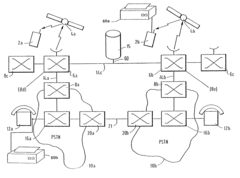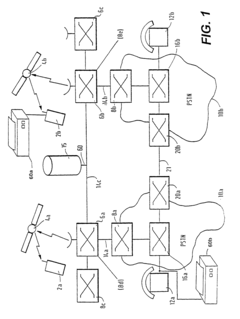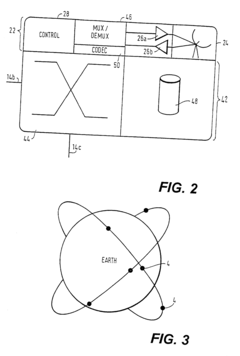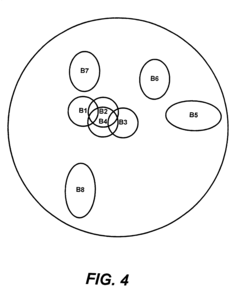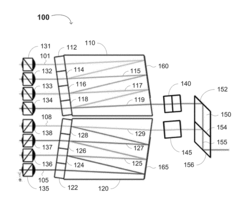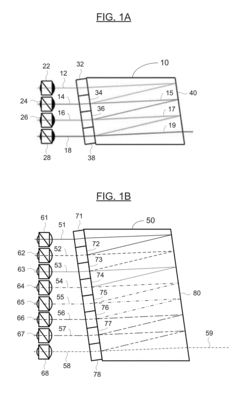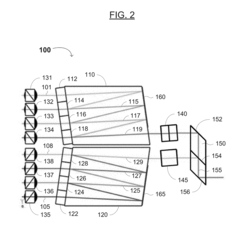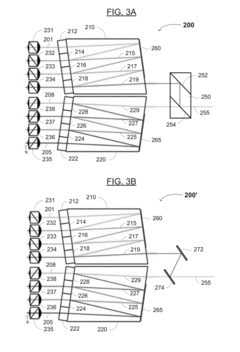Multiplexer Role in Modern Satellite Communications
JUL 11, 20259 MIN READ
Generate Your Research Report Instantly with AI Agent
Patsnap Eureka helps you evaluate technical feasibility & market potential.
Satellite Multiplexing Evolution and Objectives
Satellite multiplexing has undergone significant evolution since the inception of satellite communications. Initially, simple frequency division multiplexing (FDM) was employed to transmit multiple signals simultaneously. As technology advanced, time division multiplexing (TDM) and code division multiple access (CDMA) were introduced, enabling more efficient use of satellite bandwidth.
The primary objective of satellite multiplexing is to maximize the utilization of available satellite resources while maintaining signal integrity and minimizing interference. This goal has become increasingly crucial as the demand for satellite-based services continues to grow exponentially across various sectors, including telecommunications, broadcasting, and navigation.
In recent years, the advent of digital signal processing and advanced modulation techniques has led to the development of more sophisticated multiplexing methods. These include orthogonal frequency division multiplexing (OFDM) and polarization division multiplexing (PDM), which have significantly enhanced the capacity and flexibility of satellite communication systems.
The evolution of satellite multiplexing has been driven by the need to accommodate higher data rates, support a greater number of users, and improve overall system efficiency. As a result, modern satellite systems can now handle complex multiplexing schemes that combine multiple techniques, such as hybrid time and frequency division multiple access (TDMA/FDMA).
Looking ahead, the objectives for satellite multiplexing technology include further increasing spectral efficiency, reducing latency, and enhancing adaptability to varying channel conditions. Emerging technologies like software-defined radio (SDR) and cognitive radio systems are expected to play a crucial role in achieving these goals, enabling dynamic allocation of satellite resources based on real-time demand and environmental factors.
Another key objective is to develop multiplexing techniques that can support the integration of satellite networks with terrestrial systems, particularly in the context of 5G and future 6G networks. This integration aims to provide seamless connectivity and expand the reach of high-speed broadband services to remote and underserved areas.
As the satellite industry moves towards high-throughput satellites (HTS) and mega-constellations, multiplexing technologies must evolve to handle the increased complexity and scale of these systems. This includes developing more efficient ways to manage inter-satellite links and optimize resource allocation across vast networks of satellites.
The primary objective of satellite multiplexing is to maximize the utilization of available satellite resources while maintaining signal integrity and minimizing interference. This goal has become increasingly crucial as the demand for satellite-based services continues to grow exponentially across various sectors, including telecommunications, broadcasting, and navigation.
In recent years, the advent of digital signal processing and advanced modulation techniques has led to the development of more sophisticated multiplexing methods. These include orthogonal frequency division multiplexing (OFDM) and polarization division multiplexing (PDM), which have significantly enhanced the capacity and flexibility of satellite communication systems.
The evolution of satellite multiplexing has been driven by the need to accommodate higher data rates, support a greater number of users, and improve overall system efficiency. As a result, modern satellite systems can now handle complex multiplexing schemes that combine multiple techniques, such as hybrid time and frequency division multiple access (TDMA/FDMA).
Looking ahead, the objectives for satellite multiplexing technology include further increasing spectral efficiency, reducing latency, and enhancing adaptability to varying channel conditions. Emerging technologies like software-defined radio (SDR) and cognitive radio systems are expected to play a crucial role in achieving these goals, enabling dynamic allocation of satellite resources based on real-time demand and environmental factors.
Another key objective is to develop multiplexing techniques that can support the integration of satellite networks with terrestrial systems, particularly in the context of 5G and future 6G networks. This integration aims to provide seamless connectivity and expand the reach of high-speed broadband services to remote and underserved areas.
As the satellite industry moves towards high-throughput satellites (HTS) and mega-constellations, multiplexing technologies must evolve to handle the increased complexity and scale of these systems. This includes developing more efficient ways to manage inter-satellite links and optimize resource allocation across vast networks of satellites.
Market Demand for Advanced Satellite Communication
The demand for advanced satellite communication systems has been experiencing significant growth in recent years, driven by the increasing need for global connectivity, high-speed data transmission, and reliable communication services. This surge in demand is particularly evident in various sectors, including telecommunications, broadcasting, defense, and emerging technologies such as the Internet of Things (IoT) and autonomous vehicles.
In the telecommunications sector, satellite communication plays a crucial role in providing connectivity to remote and underserved areas where terrestrial infrastructure is limited or non-existent. As global internet penetration continues to rise, there is a growing demand for satellite-based broadband services to bridge the digital divide. This has led to the development of high-throughput satellites (HTS) and low Earth orbit (LEO) constellations, which require advanced multiplexing technologies to efficiently manage and distribute bandwidth.
The broadcasting industry has also been a significant driver of demand for advanced satellite communication systems. With the transition to high-definition and ultra-high-definition content, broadcasters require increased bandwidth and more efficient signal processing capabilities. Multiplexers play a critical role in optimizing the use of available spectrum and enabling the transmission of multiple channels over a single satellite transponder.
In the defense sector, there is a growing need for secure and reliable communication systems that can operate in challenging environments. Advanced satellite communication technologies, including sophisticated multiplexing techniques, are essential for supporting military operations, intelligence gathering, and remote sensing applications. The demand for these systems is expected to continue growing as defense organizations worldwide invest in modernizing their communication infrastructure.
The emergence of IoT and autonomous vehicles has created new opportunities and challenges for satellite communication. These technologies require ubiquitous connectivity and low-latency data transmission, which can be achieved through advanced satellite systems. Multiplexers are crucial in enabling efficient use of satellite resources to support the massive number of connected devices and the high data throughput requirements of autonomous systems.
Market research indicates that the global satellite communication market is projected to grow at a compound annual growth rate (CAGR) of over 9% from 2021 to 2026. This growth is largely attributed to the increasing demand for high-speed, reliable, and secure communication services across various industries. The multiplexer segment within the satellite communication market is expected to witness substantial growth, driven by the need for more efficient spectrum utilization and improved signal processing capabilities.
As the demand for advanced satellite communication continues to rise, there is a growing emphasis on developing more sophisticated multiplexing technologies. These include advanced frequency division multiple access (FDMA), time division multiple access (TDMA), and code division multiple access (CDMA) techniques, as well as hybrid approaches that combine multiple multiplexing methods. The market is also seeing increased interest in software-defined multiplexers that offer greater flexibility and adaptability to changing communication requirements.
In the telecommunications sector, satellite communication plays a crucial role in providing connectivity to remote and underserved areas where terrestrial infrastructure is limited or non-existent. As global internet penetration continues to rise, there is a growing demand for satellite-based broadband services to bridge the digital divide. This has led to the development of high-throughput satellites (HTS) and low Earth orbit (LEO) constellations, which require advanced multiplexing technologies to efficiently manage and distribute bandwidth.
The broadcasting industry has also been a significant driver of demand for advanced satellite communication systems. With the transition to high-definition and ultra-high-definition content, broadcasters require increased bandwidth and more efficient signal processing capabilities. Multiplexers play a critical role in optimizing the use of available spectrum and enabling the transmission of multiple channels over a single satellite transponder.
In the defense sector, there is a growing need for secure and reliable communication systems that can operate in challenging environments. Advanced satellite communication technologies, including sophisticated multiplexing techniques, are essential for supporting military operations, intelligence gathering, and remote sensing applications. The demand for these systems is expected to continue growing as defense organizations worldwide invest in modernizing their communication infrastructure.
The emergence of IoT and autonomous vehicles has created new opportunities and challenges for satellite communication. These technologies require ubiquitous connectivity and low-latency data transmission, which can be achieved through advanced satellite systems. Multiplexers are crucial in enabling efficient use of satellite resources to support the massive number of connected devices and the high data throughput requirements of autonomous systems.
Market research indicates that the global satellite communication market is projected to grow at a compound annual growth rate (CAGR) of over 9% from 2021 to 2026. This growth is largely attributed to the increasing demand for high-speed, reliable, and secure communication services across various industries. The multiplexer segment within the satellite communication market is expected to witness substantial growth, driven by the need for more efficient spectrum utilization and improved signal processing capabilities.
As the demand for advanced satellite communication continues to rise, there is a growing emphasis on developing more sophisticated multiplexing technologies. These include advanced frequency division multiple access (FDMA), time division multiple access (TDMA), and code division multiple access (CDMA) techniques, as well as hybrid approaches that combine multiple multiplexing methods. The market is also seeing increased interest in software-defined multiplexers that offer greater flexibility and adaptability to changing communication requirements.
Current Multiplexing Challenges in Satellite Systems
Satellite communication systems face several critical challenges in multiplexing, primarily due to the increasing demand for higher data rates, improved spectral efficiency, and the need to accommodate a growing number of users. One of the most pressing issues is the limited bandwidth available in satellite frequency bands, which necessitates more efficient multiplexing techniques to maximize channel capacity.
Frequency Division Multiplexing (FDM) and Time Division Multiplexing (TDM), while still widely used, are struggling to meet the escalating demands of modern satellite networks. These traditional methods are reaching their limits in terms of spectral efficiency, especially when dealing with high-throughput satellites (HTS) that require more sophisticated multiplexing solutions.
The dynamic nature of satellite traffic patterns poses another significant challenge. Traffic loads can vary greatly depending on time of day, geographical location, and specific user requirements. This variability makes it difficult to implement static multiplexing schemes that can efficiently allocate resources across all scenarios, leading to potential underutilization of satellite capacity during off-peak hours.
Interference management is becoming increasingly complex as satellite systems adopt higher frequency bands and more densely packed satellite constellations. Cross-polarization interference and adjacent satellite interference are particularly problematic, requiring advanced multiplexing techniques that can effectively isolate and mitigate these issues without compromising overall system performance.
The advent of non-geostationary satellite orbits (NGSO) systems, such as low Earth orbit (LEO) constellations, introduces new challenges in multiplexing. These systems require dynamic resource allocation and handover mechanisms to maintain continuous connectivity as satellites move relative to ground stations and users. Traditional multiplexing methods designed for geostationary satellites are often ill-suited for these more dynamic environments.
Power constraints in satellite systems also impact multiplexing strategies. Satellites have limited onboard power resources, which must be carefully managed to support multiple channels and users. This necessitates the development of energy-efficient multiplexing techniques that can maximize throughput while minimizing power consumption.
The increasing demand for flexibility in satellite services, including the ability to reconfigure beams and allocate resources on-the-fly, is pushing the boundaries of current multiplexing technologies. Adaptive and cognitive multiplexing systems that can respond to changing network conditions and user demands in real-time are becoming essential but remain challenging to implement effectively in space-based environments.
Frequency Division Multiplexing (FDM) and Time Division Multiplexing (TDM), while still widely used, are struggling to meet the escalating demands of modern satellite networks. These traditional methods are reaching their limits in terms of spectral efficiency, especially when dealing with high-throughput satellites (HTS) that require more sophisticated multiplexing solutions.
The dynamic nature of satellite traffic patterns poses another significant challenge. Traffic loads can vary greatly depending on time of day, geographical location, and specific user requirements. This variability makes it difficult to implement static multiplexing schemes that can efficiently allocate resources across all scenarios, leading to potential underutilization of satellite capacity during off-peak hours.
Interference management is becoming increasingly complex as satellite systems adopt higher frequency bands and more densely packed satellite constellations. Cross-polarization interference and adjacent satellite interference are particularly problematic, requiring advanced multiplexing techniques that can effectively isolate and mitigate these issues without compromising overall system performance.
The advent of non-geostationary satellite orbits (NGSO) systems, such as low Earth orbit (LEO) constellations, introduces new challenges in multiplexing. These systems require dynamic resource allocation and handover mechanisms to maintain continuous connectivity as satellites move relative to ground stations and users. Traditional multiplexing methods designed for geostationary satellites are often ill-suited for these more dynamic environments.
Power constraints in satellite systems also impact multiplexing strategies. Satellites have limited onboard power resources, which must be carefully managed to support multiple channels and users. This necessitates the development of energy-efficient multiplexing techniques that can maximize throughput while minimizing power consumption.
The increasing demand for flexibility in satellite services, including the ability to reconfigure beams and allocate resources on-the-fly, is pushing the boundaries of current multiplexing technologies. Adaptive and cognitive multiplexing systems that can respond to changing network conditions and user demands in real-time are becoming essential but remain challenging to implement effectively in space-based environments.
Existing Multiplexing Solutions for Satellites
01 Optical multiplexing systems
Optical multiplexers are used in fiber optic communication systems to combine multiple optical signals onto a single fiber. These systems often employ wavelength division multiplexing (WDM) techniques to increase data transmission capacity. Advanced optical multiplexers may incorporate tunable lasers, optical switches, and signal processing components to optimize performance and flexibility.- Optical multiplexing systems: Optical multiplexers are used in fiber optic communication systems to combine multiple optical signals into a single fiber. These systems often involve wavelength division multiplexing (WDM) techniques to increase data transmission capacity. Advanced optical multiplexers may incorporate tunable lasers, optical switches, and signal processing components to optimize performance and flexibility.
- Digital multiplexing for data communication: Digital multiplexers are crucial components in data communication networks, allowing multiple data streams to be combined and transmitted over a single channel. These devices employ various techniques such as time-division multiplexing (TDM) or frequency-division multiplexing (FDM) to efficiently utilize bandwidth. Advanced digital multiplexers may incorporate error correction, data compression, and adaptive modulation schemes to enhance reliability and throughput.
- Multiplexers in integrated circuits: Multiplexers play a vital role in integrated circuit design, enabling signal routing and data selection within chips. These multiplexers are often implemented using transistor-based logic gates or pass transistors. Advanced IC multiplexers may incorporate features such as low power consumption, high-speed switching, and programmable configurations to meet the demands of modern semiconductor devices.
- Wireless communication multiplexing: Multiplexing techniques are essential in wireless communication systems to efficiently utilize the available spectrum and support multiple users. These systems may employ methods such as code division multiple access (CDMA), orthogonal frequency-division multiplexing (OFDM), or spatial multiplexing in MIMO systems. Advanced wireless multiplexers often incorporate adaptive algorithms to optimize performance in changing channel conditions.
- Multiplexers for sensor and control systems: Multiplexers are used in various sensor and control applications to manage multiple input or output signals. These devices allow for efficient data acquisition, signal processing, and control of multiple sensors or actuators. Advanced multiplexers in this domain may incorporate features such as programmable gain, auto-calibration, and built-in diagnostics to enhance system performance and reliability.
02 Digital multiplexing in telecommunications
Digital multiplexers are crucial components in telecommunications networks, enabling the combination of multiple digital data streams into a single transmission channel. These devices use time division multiplexing (TDM) or frequency division multiplexing (FDM) techniques to efficiently utilize bandwidth. Advanced digital multiplexers may incorporate error correction, compression, and encryption features to enhance data integrity and security.Expand Specific Solutions03 Multiplexers in integrated circuits
Multiplexers play a vital role in integrated circuit design, allowing for the selection of one input from multiple inputs based on control signals. These components are widely used in digital logic circuits, memory systems, and data processing units. Advanced multiplexer designs may incorporate high-speed switching, low power consumption, and reduced chip area to meet the demands of modern semiconductor technologies.Expand Specific Solutions04 Multiplexing in wireless communication systems
Multiplexers are essential in wireless communication systems for efficiently sharing limited spectrum resources among multiple users or data streams. Techniques such as code division multiple access (CDMA) and orthogonal frequency-division multiplexing (OFDM) are employed to increase system capacity and improve spectral efficiency. Advanced multiplexing schemes may incorporate adaptive modulation, beamforming, and multi-user MIMO to enhance performance in challenging wireless environments.Expand Specific Solutions05 Multiplexers in sensor and imaging systems
Multiplexers are used in various sensor and imaging applications to combine multiple input signals or to select specific sensor outputs for processing. In imaging systems, multiplexers enable the readout of large sensor arrays, while in multi-sensor systems, they allow for efficient data collection and processing. Advanced multiplexer designs in this field may incorporate on-chip signal conditioning, analog-to-digital conversion, and intelligent power management to optimize system performance and energy efficiency.Expand Specific Solutions
Key Satellite Communication Industry Players
The multiplexer role in modern satellite communications is evolving within a competitive landscape characterized by rapid technological advancements and growing market demand. The industry is in a mature growth phase, with a global market size expected to reach billions of dollars in the coming years. Companies like QUALCOMM, Toshiba, and Mitsubishi Electric are at the forefront, leveraging their expertise in semiconductor technologies and communications systems to develop advanced multiplexing solutions. The technology's maturity varies, with established players like Sony and Samsung pushing boundaries in miniaturization and efficiency, while newer entrants like SnapTrack and AST & Science focus on innovative approaches to address emerging challenges in satellite communications.
QUALCOMM, Inc.
Technical Solution: QUALCOMM has developed innovative multiplexer technologies for satellite-to-mobile device communications, leveraging its expertise in 5G and cellular technologies. Their approach focuses on integrating satellite connectivity into standard smartphone chipsets, utilizing advanced software-defined radio (SDR) techniques to enable flexible multiplexing schemes[1]. QUALCOMM's multiplexers support both time and frequency division multiplexing, with the ability to dynamically switch between terrestrial and satellite networks. The company has implemented sophisticated beam management algorithms to optimize connectivity in challenging environments[3]. QUALCOMM's technology also incorporates advanced power management features to minimize battery drain during satellite communications. Their multiplexers are designed to operate across multiple frequency bands, including S-band and L-band, to ensure compatibility with various satellite constellations[5].
Strengths: Seamless integration with existing mobile devices, efficient power management, and multi-band support. Weaknesses: May face challenges in achieving high data rates compared to dedicated satellite terminals, potential regulatory hurdles in some regions.
Telefonaktiebolaget LM Ericsson
Technical Solution: Ericsson has developed innovative multiplexer technologies for satellite communications, focusing on 5G integration and IoT connectivity. Their multiplexers utilize advanced beamforming techniques to create multiple, steerable beams, significantly increasing satellite capacity and coverage[2]. Ericsson's solution incorporates AI-driven adaptive multiplexing, which dynamically adjusts multiplexing parameters based on real-time traffic patterns and atmospheric conditions[4]. The company has also pioneered the use of optical multiplexing in satellite payloads, enabling ultra-high-speed inter-satellite links and ground-to-satellite communications[6]. Ericsson's multiplexers are designed to support seamless integration between terrestrial and satellite networks, facilitating global 5G coverage.
Strengths: Cutting-edge AI and beamforming technologies, seamless integration with 5G networks, and high-capacity optical communications. Weaknesses: May require significant infrastructure upgrades for full implementation, potentially higher latency in some applications.
Core Innovations in Satellite Multiplexing Techniques
Satellite communications with satellite routing according to channels assignment signals
PatentInactiveUS20020122408A1
Innovation
- A TDMA satellite communications system that routes individual TDMA bursts of a given frequency channel separately from frame to frame, using a network of non-geostationary satellites with omnidirectional user terminals and a dedicated ground-based network, allowing for efficient use of bandwidth through time division multiple access and dynamic channel allocation.
Multi-channel optical multiplexers and demultiplexers, optical transmitter, receiver and transceiver comprising the same, and methods of making and using the same
PatentActiveUS20180212708A1
Innovation
- The design incorporates two structural blocks with mirrors and filters, each capable of combining multiple optical signals, and a beam combiner to form a multi-channel optical signal, allowing for independent adjustment and reducing geometric errors, while maintaining a compact size similar to systems with fewer channels.
Regulatory Framework for Satellite Communications
The regulatory framework for satellite communications plays a crucial role in governing the use of multiplexers in modern satellite systems. This framework is established by international organizations, national governments, and regional bodies to ensure efficient and fair use of the limited radio frequency spectrum and orbital resources.
At the international level, the International Telecommunication Union (ITU) is the primary body responsible for coordinating global satellite communications regulations. The ITU's Radio Regulations provide guidelines for frequency allocation, orbital slot assignments, and interference mitigation techniques, which directly impact the design and operation of multiplexers in satellite systems.
National regulatory bodies, such as the Federal Communications Commission (FCC) in the United States and the European Conference of Postal and Telecommunications Administrations (CEPT) in Europe, implement and enforce these international regulations within their jurisdictions. These agencies also develop additional rules and standards specific to their regions, which may influence multiplexer specifications and performance requirements.
The regulatory framework addresses several key aspects of satellite communications that are relevant to multiplexer technology. These include frequency band allocations for different satellite services, power limits to prevent interference, and technical standards for modulation schemes and signal processing techniques. Multiplexers must be designed and operated in compliance with these regulations to ensure seamless integration into the global satellite communications ecosystem.
One of the primary regulatory concerns is the efficient use of the radio frequency spectrum. Multiplexers play a vital role in this aspect by enabling multiple channels to share the same frequency band, thereby increasing spectral efficiency. Regulatory bodies often mandate specific frequency reuse patterns and channel spacing requirements, which directly influence multiplexer design and implementation.
Another important regulatory consideration is the prevention of harmful interference between satellite systems and other radio services. Multiplexers must adhere to strict out-of-band emission limits and filtering requirements to minimize the potential for interference. Regulatory frameworks often specify these technical parameters, which manufacturers and operators must meet to obtain necessary licenses and approvals.
The regulatory landscape for satellite communications is continually evolving to keep pace with technological advancements and changing market demands. As new multiplexing techniques and technologies emerge, regulatory bodies must adapt their frameworks to accommodate these innovations while maintaining order in the satellite communications ecosystem. This ongoing process involves regular reviews and updates to existing regulations, as well as the development of new standards and guidelines.
At the international level, the International Telecommunication Union (ITU) is the primary body responsible for coordinating global satellite communications regulations. The ITU's Radio Regulations provide guidelines for frequency allocation, orbital slot assignments, and interference mitigation techniques, which directly impact the design and operation of multiplexers in satellite systems.
National regulatory bodies, such as the Federal Communications Commission (FCC) in the United States and the European Conference of Postal and Telecommunications Administrations (CEPT) in Europe, implement and enforce these international regulations within their jurisdictions. These agencies also develop additional rules and standards specific to their regions, which may influence multiplexer specifications and performance requirements.
The regulatory framework addresses several key aspects of satellite communications that are relevant to multiplexer technology. These include frequency band allocations for different satellite services, power limits to prevent interference, and technical standards for modulation schemes and signal processing techniques. Multiplexers must be designed and operated in compliance with these regulations to ensure seamless integration into the global satellite communications ecosystem.
One of the primary regulatory concerns is the efficient use of the radio frequency spectrum. Multiplexers play a vital role in this aspect by enabling multiple channels to share the same frequency band, thereby increasing spectral efficiency. Regulatory bodies often mandate specific frequency reuse patterns and channel spacing requirements, which directly influence multiplexer design and implementation.
Another important regulatory consideration is the prevention of harmful interference between satellite systems and other radio services. Multiplexers must adhere to strict out-of-band emission limits and filtering requirements to minimize the potential for interference. Regulatory frameworks often specify these technical parameters, which manufacturers and operators must meet to obtain necessary licenses and approvals.
The regulatory landscape for satellite communications is continually evolving to keep pace with technological advancements and changing market demands. As new multiplexing techniques and technologies emerge, regulatory bodies must adapt their frameworks to accommodate these innovations while maintaining order in the satellite communications ecosystem. This ongoing process involves regular reviews and updates to existing regulations, as well as the development of new standards and guidelines.
Environmental Impact of Satellite Technology
The environmental impact of satellite technology is a growing concern as the number of satellites in orbit continues to increase. While satellites play a crucial role in modern communications, including the use of multiplexers for efficient data transmission, their presence in space has both positive and negative effects on the Earth's environment.
One of the primary environmental benefits of satellite technology is its contribution to Earth observation and climate monitoring. Satellites equipped with advanced sensors and imaging systems provide valuable data on global weather patterns, ocean temperatures, and atmospheric composition. This information is essential for tracking climate change, predicting natural disasters, and developing effective environmental policies.
However, the proliferation of satellites also raises concerns about space debris. As more satellites are launched, the risk of collisions and the generation of orbital debris increases. This debris can pose a threat to operational satellites and spacecraft, potentially leading to a cascade of collisions known as the Kessler syndrome. The accumulation of space junk may hinder future space exploration and satellite deployment efforts.
The launch and operation of satellites also contribute to carbon emissions. Rocket launches release significant amounts of greenhouse gases and particulate matter into the atmosphere. Although the overall impact is relatively small compared to other industries, the growing frequency of launches may lead to increased environmental concerns in the future.
Satellite technology's impact on light pollution is another environmental consideration. The increasing number of satellites in low Earth orbit can create visible streaks across the night sky, potentially interfering with astronomical observations and affecting nocturnal wildlife. This issue has sparked debates within the scientific community about the balance between technological progress and preserving dark skies.
On the other hand, satellite communications, facilitated by multiplexers and other advanced technologies, enable more efficient resource management and environmental monitoring. For instance, precision agriculture techniques using satellite data can optimize crop yields while reducing water and pesticide usage. Similarly, satellite-based monitoring systems help detect and prevent illegal deforestation and fishing activities.
The disposal of satellites at the end of their operational life is an emerging environmental challenge. While many satellites are designed to burn up upon re-entry into the Earth's atmosphere, larger satellites may require controlled de-orbiting to minimize the risk of debris reaching the ground. Developing sustainable end-of-life strategies for satellites is crucial to mitigate long-term environmental impacts.
One of the primary environmental benefits of satellite technology is its contribution to Earth observation and climate monitoring. Satellites equipped with advanced sensors and imaging systems provide valuable data on global weather patterns, ocean temperatures, and atmospheric composition. This information is essential for tracking climate change, predicting natural disasters, and developing effective environmental policies.
However, the proliferation of satellites also raises concerns about space debris. As more satellites are launched, the risk of collisions and the generation of orbital debris increases. This debris can pose a threat to operational satellites and spacecraft, potentially leading to a cascade of collisions known as the Kessler syndrome. The accumulation of space junk may hinder future space exploration and satellite deployment efforts.
The launch and operation of satellites also contribute to carbon emissions. Rocket launches release significant amounts of greenhouse gases and particulate matter into the atmosphere. Although the overall impact is relatively small compared to other industries, the growing frequency of launches may lead to increased environmental concerns in the future.
Satellite technology's impact on light pollution is another environmental consideration. The increasing number of satellites in low Earth orbit can create visible streaks across the night sky, potentially interfering with astronomical observations and affecting nocturnal wildlife. This issue has sparked debates within the scientific community about the balance between technological progress and preserving dark skies.
On the other hand, satellite communications, facilitated by multiplexers and other advanced technologies, enable more efficient resource management and environmental monitoring. For instance, precision agriculture techniques using satellite data can optimize crop yields while reducing water and pesticide usage. Similarly, satellite-based monitoring systems help detect and prevent illegal deforestation and fishing activities.
The disposal of satellites at the end of their operational life is an emerging environmental challenge. While many satellites are designed to burn up upon re-entry into the Earth's atmosphere, larger satellites may require controlled de-orbiting to minimize the risk of debris reaching the ground. Developing sustainable end-of-life strategies for satellites is crucial to mitigate long-term environmental impacts.
Unlock deeper insights with Patsnap Eureka Quick Research — get a full tech report to explore trends and direct your research. Try now!
Generate Your Research Report Instantly with AI Agent
Supercharge your innovation with Patsnap Eureka AI Agent Platform!
